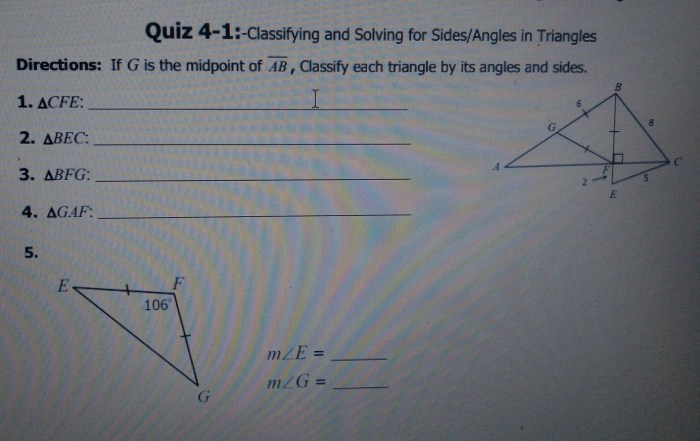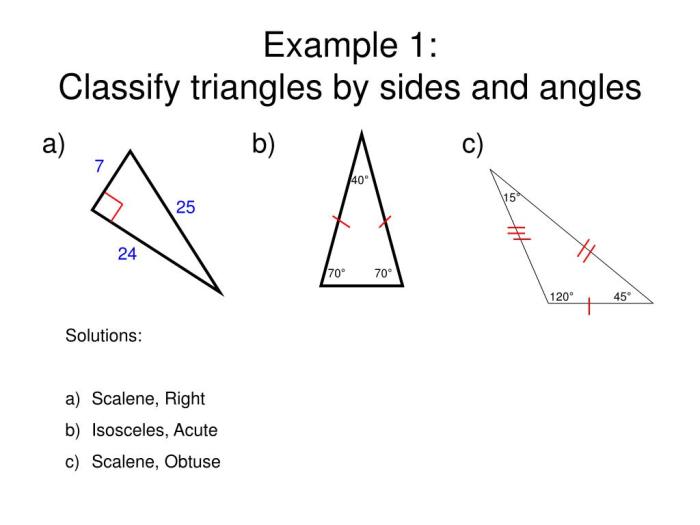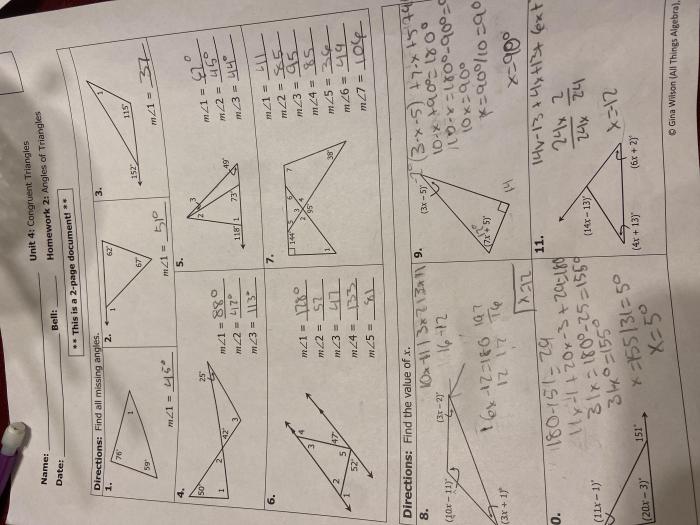Quiz 4-1 Classifying and Solving for Sides/Angles in Triangles Answers introduces the fascinating realm of triangle geometry, equipping readers with the knowledge to classify triangles based on their sides and angles and solve for unknown sides and angles. This comprehensive guide unveils the secrets of triangles, providing a solid foundation for further exploration in geometry.
Delving into the intricacies of triangles, this guide explores the Pythagorean theorem and angle sum property, empowering readers to tackle problems involving unknown side lengths and angle measures with confidence. Step-by-step instructions and practice problems reinforce understanding, making this guide an invaluable resource for students and geometry enthusiasts alike.
Classifying Triangles

Triangles are classified based on their side lengths and angle measures. Understanding these classifications is crucial for solving problems involving triangles.
Classifying Triangles by Sides
Triangles can be classified into three types based on the lengths of their sides:
- Equilateral Triangle:All three sides are equal in length.
- Isosceles Triangle:Two sides are equal in length.
- Scalene Triangle:All three sides are different lengths.
Classifying Triangles by Angles
Triangles can also be classified into three types based on the measures of their angles:
- Acute Triangle:All three angles are less than 90 degrees.
- Right Triangle:One angle is exactly 90 degrees.
- Obtuse Triangle:One angle is greater than 90 degrees.
Solving for Unknown Sides in Triangles
The Pythagorean theorem is a fundamental tool for finding unknown side lengths in right triangles.
Pythagorean Theorem:In a right triangle, the square of the hypotenuse (the side opposite the right angle) is equal to the sum of the squares of the other two sides.
Steps to Use the Pythagorean Theorem:
- Identify the right triangle.
- Label the known side lengths as “a” and “b”.
- Label the unknown side length as “c”.
- Substitute the known values into the Pythagorean theorem equation: c2= a 2+ b 2.
- Solve for “c” by taking the square root of both sides of the equation.
Solving for Unknown Angles in Triangles, Quiz 4-1 classifying and solving for sides/angles in triangles answers
The angle sum property states that the sum of the interior angles of a triangle is always 180 degrees.
Steps to Use the Angle Sum Property:
- Identify the triangle.
- Label the known angle measures as “A” and “B”.
- Label the unknown angle measure as “C”.
- Substitute the known values into the angle sum property equation: A + B + C = 180.
- Solve for “C” by subtracting the known angles from 180 degrees.
FAQ Summary: Quiz 4-1 Classifying And Solving For Sides/angles In Triangles Answers
What are the different types of triangles based on side lengths?
Triangles can be classified as equilateral (all sides equal), isosceles (two sides equal), or scalene (no sides equal).
How can I find the unknown side length of a triangle using the Pythagorean theorem?
Use the formula a^2 + b^2 = c^2, where a and b are the lengths of the known sides and c is the length of the unknown side.
What is the angle sum property of triangles?
The sum of the interior angles of any triangle is always 180 degrees.



